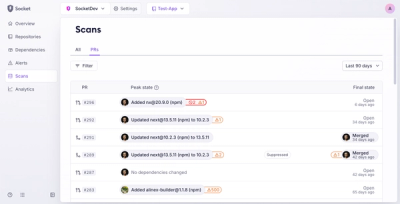
Research
/Security News
DuckDB npm Account Compromised in Continuing Supply Chain Attack
Ongoing npm supply chain attack spreads to DuckDB: multiple packages compromised with the same wallet-drainer malware.
rettiwt-auth
Advanced tools
A CLI tool for authenticating against Twitter API
The package is intended to be installed globally.
npm install -g rettiwt-authyarn global add rettiwt-authThe following are the two types of authentcation methods available, with each method providing access to different set of resources:
The following examples demonstrate authenticating against Twitter API and generating the credentials.
Install the package globally by following the steps in the 'Installation' section.
Open a commandline/shell and use the command:
rettiwt-auth user <email> <username> <password>
Where,
<email> is the email to the Twitter account.<username> is the username associated with the Twitter account.<password> is the password to the Twitter account.Store the generated API key in a safe spot for later use.
Install the package globally by following the steps in the 'Installation' section.
Open a commandline/shell and use the command:
rettiwt-auth user -h <email> <username> <password>
Where,
<email> is the email to the Twitter account.<username> is the username associated with the Twitter account.<password> is the password to the Twitter account.The -h option specifies the CLI to generate the credentials as HTTP headers.
Store the generated API key in a safe spot for later use.
For authenticating the requests to Twitter, append the headers to outgoing HTTP requests.
In order to use a proxy while creating either 'guest' or 'user' credentials, use the option -p <URL_to_proxy> or --proxy <URL_to_proxy> to specify the proxy server to use. The following snippet demonstrates using a proxy for generating 'user' credentials:
rettiwt-auth user -p <URL> <email> <username> <password>
Where,
<URL> is he URL to the proxy server to use.<email> is the email to the Twitter account.<username> is the username associated with the Twitter account.<password> is the password to the Twitter account.To get a list of all commands available, use the command:
rettiwt-auth help
To check the description of single command, use the command:
rettiwt-auth help <command_name>
Where,
<command_name> is the name of a specific command from the list of available commandsWhen you generate the credentials as API key/HTTP headers,
The generated API key/HTTP headers are valid for a duration of 1 year, starting from the day of generation.
As such, it is suggested to generated the API key/HTTP headers once, then store them in a safe place (such as in an environment variable or a JSON file).
Notes:
Whenever it is required to authenticate against Twitter API, use the stored API key/HTTP headers.
FAQs
A CLI tool for authenticating against Twitter API
The npm package rettiwt-auth receives a total of 418 weekly downloads. As such, rettiwt-auth popularity was classified as not popular.
We found that rettiwt-auth demonstrated a not healthy version release cadence and project activity because the last version was released a year ago. It has 1 open source maintainer collaborating on the project.
Did you know?

Socket for GitHub automatically highlights issues in each pull request and monitors the health of all your open source dependencies. Discover the contents of your packages and block harmful activity before you install or update your dependencies.

Research
/Security News
Ongoing npm supply chain attack spreads to DuckDB: multiple packages compromised with the same wallet-drainer malware.

Security News
The MCP Steering Committee has launched the official MCP Registry in preview, a central hub for discovering and publishing MCP servers.

Product
Socket’s new Pull Request Stories give security teams clear visibility into dependency risks and outcomes across scanned pull requests.